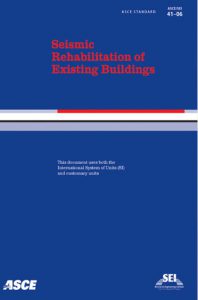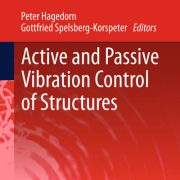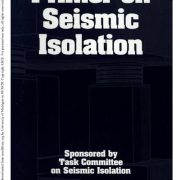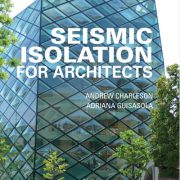Seismic Rehabilitation of Existing Buildings
1.0 REHABILITATION REQUIREMENTS1.1 SCOPEThis standard for the Seismic.
Rehabilitation ofExisting Buildings, referred to herein as “this stan-dard,” specifies nationally applicable provisions for theseismic rehabilitation of buildings. Seismic rehabilita-tion is defined as improving the seismic performanceof structural and/or nonstructural components of abuilding by correcting deficiencies identified in a seis-mic evaluation.
Seismic evaluation
is defined as anapproved process or methodology of evaluating defi-ciencies in a building, which prevent the building fromachieving a selected Rehabilitation Objective. Seismicevaluation using ASCE 31 (ASCE 2002), the proce-dures and criteria of this standard, or other proceduresand criteria approved by the authority having jurisdic-tion is permitted.Seismic rehabilitation of existing buildings shallcomply with requirements of this standard for select-ing a Rehabilitation Objective and conducting the seis-mic rehabilitation process to achieve the selectedRehabilitation Objective. This standard does not pre-clude a building from being rehabilitated by other pro-cedures approved by the authority having jurisdiction.
Symbols, acronyms, definitions,
Symbols, acronyms, definitions, and referencesused throughout this standard are cited separately insections located at the end of this standard. C1.1 SCOPEThis standard is intended to serve as a nationallyapplicable tool for design professionals, code officials,and building owners undertaking the seismic rehabili-tation of existing buildings. In jurisdictionally man-dated seismic rehabilitation programs, the code officialserves as the authority having jurisdiction. In volun-tary seismic rehabilitation programs, the buildingowner, or the owner’s designated agent, serves as theauthority having jurisdiction. This standard consists of two parts: Provisions,which contain the technical requirements, andCommentary, intended to explain the provisions.Commentary for a given section is located immediatelyfollowing the section and is identified by the same sec-tion number preceded by the letter C.It is expected that most buildings rehabilitated inaccordance with this standard would perform withinthe desired levels when subjected to the design earth-quakes.
design earth-quakes
However, compliance with this standard doesnot guarantee such performance; rather, it representsthe current standard of practice in designing to attainthis performance. The practice of earthquake engineer-ing is rapidly evolving, and both our understanding ofthe behavior of buildings subjected to strong earth-quakes and our ability to predict this behavior areadvancing. In the future, new knowledge and technol-ogy will improve the reliability of accomplishing thesegoals.The procedures contained in this standard arespecifically applicable to the rehabilitation of existingbuildings and, in general, are more appropriate for thatpurpose than are new building codes. New buildingcodes are primarily intended to regulate the design andconstruction of new buildings; as such, they includemany provisions that encourage or require the develop-ment of designs with features important for good seismicperformance, including regular configuration, structuralcontinuity, ductile detailing, and materials of appropri-ate quality.
Many existing buildings were designed
Many existing buildings were designed andconstructed without these features and contain charac-teristics such as unfavorable configuration and poordetailing that preclude application of building code pro-visions for their seismic rehabilitation. Although it is intended to be used as a follow-upto a previous seismic evaluation, this standard can alsobe used as an evaluation tool to ascertain compliancewith a selected rehabilitation objective. An ASCE 31,Tier 3 evaluation is an example of this use. It shouldbe noted, however, that an evaluation using this stan-dard may be more stringent than other evaluationmethodologies because the provisions have been cali-brated for use in design. Historically, criteria for evalu-ation have been set lower than those for design to minimize the need to strengthen buildings that wouldotherwise have only modest deficiencies.The expertise of the design professional in earth-quake engineering is an important prerequisite for theappropriate use of this standard in assisting a buildingowner to select voluntary seismic criteria or to designand analyze seismic rehabilitation projects, whethervoluntary or required. The analytical work required bythis standard must be performed under the responsiblecharge of a licensed professional engineer; however,that does not preclude a design professional without aprofessional engineering license, but with responsiblecharge, from leading a seismic rehabilitation project
Detials:
| عنوان |
Seismic Rehabilitation of Existing Buildings |
| نویسنده | This document uses both the International System of Units (SI) and customary units |
| زبان | English |
| Size | 4.35 MB |
| Download Method | مستقیم |
| Download Links | Download Seismic Rehabilitation of Existing Buildings |






 تهران، شهرک غرب، بلوار خوردین، بلوار شریفی، توحید 4، پلاک 6، واحد 111
تهران، شهرک غرب، بلوار خوردین، بلوار شریفی، توحید 4، پلاک 6، واحد 111

 Response Control and Seismic Isolation of Buildings
Response Control and Seismic Isolation of Buildings